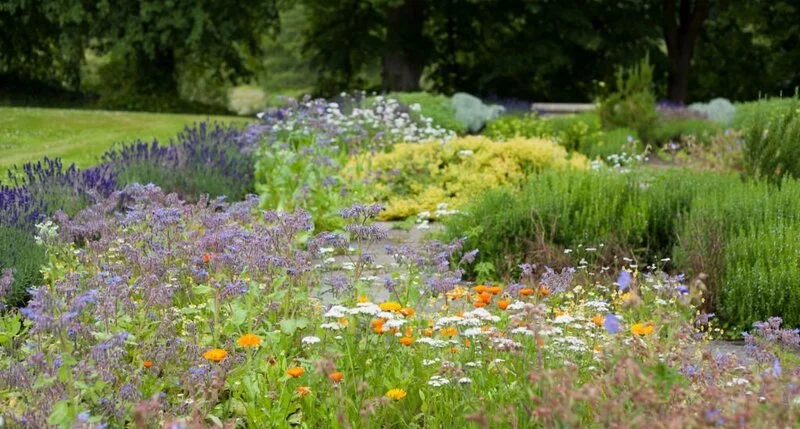Welcome, green thumbs and budding gardeners! Let’s dive into the fragrant world of rosemary. You’ve likely savored it in your favorite recipes, but have you considered the plant’s life outside the kitchen? This tough and aromatic herb is not just a culinary star, but also a fantastic team player in your garden.
Rosemary: Its Growth Habit and Needs
Rosemary, with its beautiful, needle-like leaves and small, pale-blue flowers, is more than just a pretty face in the garden. Native to the Mediterranean, rosemary loves sunshine and well-drained soil. It’s a woody perennial that thrives in zones 7-10, and can flourish indoors with the right care. It’s important to know that rosemary’s roots reach deep into the soil to find water. So, it prefers not to have wet feet and is happiest when the soil dries out a bit between watering.
Benefits of Companion Planting with Rosemary
Now, let’s look at the magic of companion planting – it’s like matchmaking for plants! The basic idea is that certain plants grow better together. They might help each other by deterring pests, improving the soil, or simply by being a good neighbor. And our star, rosemary, is one such plant. It not only keeps away certain pests with its strong aroma, but it can also thrive alongside various other plants. Let’s dive into which plants make the best roommates for rosemary.
Best Companion Plants for Rosemary
When it comes to pairing up, rosemary is pretty easygoing. It gets along well with many plants. Some of its best pals are cabbage, beans, and carrots. These plants benefit from rosemary’s strong scent, which keeps away many common garden pests. Other friends include sage and thyme. They share similar sun and soil preferences, making them great companions.
- Beautiful – Large premium seed packet of Contender Bush Bean (Phaseolus vulgaris) seeds. Minimum of 16.5g per packet (about 30 seeds). Stringless bush bean that matures early and produces high yields. Adaptable, performing well in short, cool growing seasons or in hot weather. Beans are 5-8″ long and retain their flavor when frozen or canned.
- Productive – Contender Bean germinates in 7-12 days when soil temps are 65-75°F. Plant 1” deep and space 3-4” apart in an area with full sun. This variety will grow 12-22” tall with a spread of 16-20”. Beans will mature in 60-75 days, plant in USDA zones 3-10.
- Good Eats – Fresh beans are a garden treat. Roast your beans or sautee them for a delicious dinner addition, or eat them raw straight from the garden for a tasty snack! Beans will also hold up well when frozen or canned.
- Easy to Grow – Instructions included on each packet. Plus, we are available to answer all your questions. If these seeds don’t germinate, we will happily make it right for you.
- Safe and Sustainable – Our operation is fully solar powered, and Sow Right Seeds has taken the Safe Seed Pledge to sell only fresh Non-GMO heirloom seeds for you and your family.
Plants to Avoid Planting with Rosemary
While rosemary is friendly, it does have some plants it doesn’t quite gel with. For example, avoid planting it with water-loving plants like cucumbers or squash. These plants need a lot of water, which could lead to overwatering and root rot in your rosemary. Additionally, avoid planting rosemary too close to potatoes, as they could attract pests that harm rosemary.
How to Plant Rosemary with Other Plants: A Step-by-Step Guide
Ready to create your rosemary companion garden? Let’s walk through the steps. First, choose the location. Remember, rosemary loves sun. Next, prepare the soil by ensuring good drainage. Then, plant your rosemary. Leave a good amount of space around it to avoid overcrowding. Now, plant your companion plants. Keep in mind their individual needs. Lastly, water your plants as needed, and remember that rosemary likes to dry out between waterings. Voila! Your companion garden is ready to thrive.
- ALL-IN-ONE POTTING SOIL SOLUTION: FoxFarm ocean forest potting soil is a blend designed to give your plants everything they need to thrive. Ideal for container plants, this planting soil provides optimal nutrient and soil aeration
- MOISTURE-LOCKING NUTRIENT BLEND: This organic potting soil for plant is packed with aged forest products, sphagnum peat moss, earthworm castings, bat guano, and fish emulsion, each ingredient enhances moisture retention and nutrient uptake
- TOP-NOTCH SOIL FOR EVERY PLANT: From roses and shrubs to seedlings and trees, this garden soil supports vigorous growth and branching. This outdoor & indoor plant soil’s pH-adjusted blend promotes healthy, lush foliage for all plant varieties
- YOUR GO-TO SOIL FOR ALL MEDIUMS: Our potting soil mix is perfect for container gardens, houseplants, and outdoor setups. Ocean plant versatile blend provides a balanced environment for robust growth, ensuring your plants thrive in any setting
- CONVENIENT SOIL READY TO USE: This houseplant potting soil is ready to use out of the bag, no additional ingredients are needed. Use for planting or top-dressing, with the optional pairing of FoxFarm liquid fertilizers for enhanced growth all season
Caring for Your Rosemary and Its Companions
Caring for your rosemary and its plant friends isn’t difficult. Remember, most of these plants enjoy full sun and well-drained soil. Don’t overwater them, as they prefer soil that dries out between watering. Prune your rosemary regularly to encourage bushy growth and prevent legginess. Also, pay attention to your companion plants and cater to their specific needs. With the right care, you can enjoy a flourishing garden with a variety of beautiful, healthy plants.
Conclusion
Companion planting with rosemary can be a rewarding experience, allowing you to make the most of your garden space while also enhancing the health and productivity of your plants. Whether you’re a gardening newbie or a seasoned expert, planting rosemary with compatible companions can take your garden to new heights. So go ahead, give it a try, and see your garden thrive like never before. Happy gardening!





